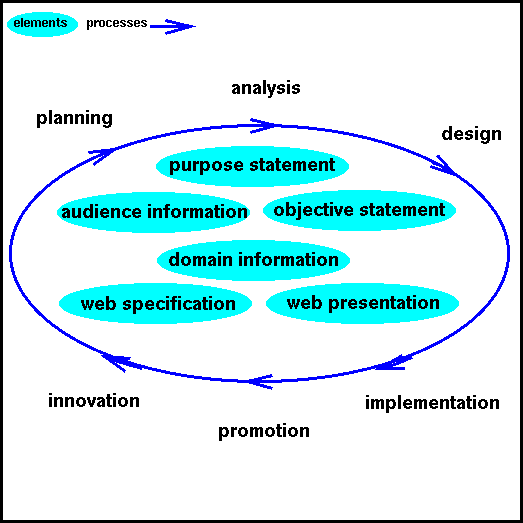Summary
In developing a web, you'll create information which will help you while accomplishing the web development processes. Here are the elements of information:- Audience information is a store of knowledge about the target audience for the web as well as the actual audience who uses the information.
- The purpose statement is an articulation of the reason for and scope of the web's existence.
- The objectives list flows from the purpose statement and defines the specific goals the web should accomplish.
- The domain information is a collection of knowledge and information about the subject domain the web covers, both in terms of information provided to users of the web and information the web developers need.
- The web specification is a detailed description of the constraints and elements that will go into the web.
- The web presentation is the means by which the information is delivered to the user.
Discussion

Elements of Web Development
Web elements and processes are interconnected, and decisions that web developers make rely on these interconnections. As such, there is redundancy in the methodology. If any one element or process is weak, another stronger element or process might be able to compensate. A good implementation sometimes can make up for a bad design, for example. A good objective statement can make up for a poor purpose statement. The goal is not to have these weaknesses but to counter the inevitable problems that result. The elements of the web-development methodology follow:
Audience information. A store of knowledge about the target audience for the web as well as the actual audience who uses the information. This information includes the audience's background, interests, proclivities, and all detail helpful to shaping the information to suit the users' needs. All this information might not be complete at any time during the web-development process; a store of information develops over time. The audience information might be very useful and accurate at one time; it then might pass out of currency as different users start accessing the web.
Purpose statement. An articulation of the reason for and scope of the web's existence. At all times during development, a developer should have a succinct purpose statement for the web. This statement might be in general terms, such as "To create a presence for our company in cyberspace," or it might be very specific, such as "To provide information about our company's new line of modems." This purpose statement itself is dynamic; over time, an organization that started a web to "establish presence in cyberspace" might want to make that web serve another, more specific purpose. A succinct statement of this purpose, however general, serves as a guidepost for the web-development processes.
Objective statement. Flows from the purpose statement and defines what specific goals the web should accomplish. An objective statement based on the purpose used in the preceding paragraph, "To provide information about our company's new line of modems," might include a statement of the modems the company offers and the kind of information that should be given (pictures, prices, schematics, and so on). Like the audience information and purpose statements, the objective statement is dynamic, and it might become necessary later in web development to define still other statements. Therefore, the objective statement changes as the purpose of the web changes, but also as the information about the audience changes. The audience looking at the modems suddenly might become very concerned about display buttons on the devices themselves, for example. In that case, an objective might be created to include pictures of modems on the web itself.
Domain information. A collection of knowledge and information about the subject domain that the web covers, both in terms of information provided to users of the web and information that the web developers need. A web offering modems for sale also might necessarily draw on a variety of information about the use, mechanics, principles, and specifications for modems. Although not all this information would necessarily be made available to the users of the web, this domain knowledge might be essential for the web developers to have. Often, this domain knowledge makes a good complement to the information the web already offers. A modem manufacturer with a good collection of modem facts, for example, might find that interested buyers visit that web for technical information about modems and, in the course of this visit, are informed of a company's products.
Web specification. A detailed description of the constraints and elements that will go into the web. The specification statement lists what pieces of information will be presented as well as any limitations on the presentation. One part of a specification might state that the picture of the modem must be placed on the same hypertext page as a link to an order form, for example. The specification, as with all the other elements of the web, might be in constant flux.
Web presentation. The means by which the information is delivered to the user. The presentation is the result of design and implementation processes that build on the web specification. In these processes, creative choices are made among design and presentation techniques to achieve the web specification; considerations for efficiency, aesthetics, and known web-usage patterns also are made.
This list of the elements involved in the web-development methodology shows that there are many interactions and relationships among them. In fact, all the elements depend on the best information being available about the other elements in order to be successful. A web developer, for example, needs to know whether the objective is to sell modems or to educate people about modems when designing a particular piece of a web. Similarly, the elements interact with the processes of the methodology.


